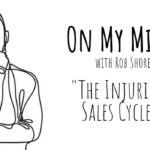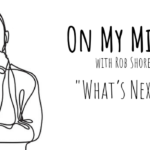It seems almost magical.
When you experience a service or sales encounter that justs hits on all the right cylinders.
And because of that you feel compelled to speak highly of and refer that company/professional.
How can wholesalers create that magic on purpose?
For over 20 years, Michael Hoffman has been helping companies build sales, radically shift their culture, develop their leaders, and engage employees in delivering true customer service.
Michael is an expert at changing mindsets of teams at all levels.
His practical tips and techniques provide necessary tools for people to approach their work “on purpose”.
He focuses everyone’s attention on owning their attitudes and sharing responsibility for contributing their best daily—especially in the “tornado of business” where change is now a constant factor.
To inquire about booking Michael Hoffman for your next event through Wholesaler Masterminds Speakers Bureau contact us at info@wholesalermasterminds.com
Planning an Advisor Roadshow? Let us help you extract a better ROI than you have ever experienced. Read about our Roadshow Plans.
How to OWN IT and Create an Influential Advisor Encounter
We’ve all had those interactions where we walk away from the sales, customer service, or even management encounters saying:
“That’s why I shop here!”
You’ve had them, those encounters that have real impact on the value provided by the companies those people represent. When you’ve had an encounter with a salesperson that you didn’t make you feel sold, or a customer service person that had you saying, “thank God I got you!” or a boss that you’d run through a burning building vs. wanting to stay in the building.
Well the same goes for how you differentiate yourself as a wholesaler instead as just another vendor.
Here are a just a few reminders of how people who truly own the experience say and do “on purpose” to have real influence.
It’s a good thing to remind ourselves of the basics and get back into those good habits:
Ask, ask, ask – We try to solve too quickly. Get the whole story!
I know you think you know the situation but you probably don’t.
At best, you still don’t know their side completely, even though your years of experience may convince you that you’ve heard this before and you know what’s going on.
The truth is that when dealing with people we can serve what feels like the same situation, but the reality is that multiple people with the same situation can have multiple needs they are trying to solve.
So instead of wasting time throwing out solutions only to be told how that might not work because… (or worse they just take your suggestions and promptly throw them into the circular file in their mind), give yourself permission to seek more information.
With a few additional questions, you may find a clearer target or focus that may save you a lot of time and allow you to give stronger solutions.
The art of the follow up question
I once heard it said that the art of conversation is the art of the follow up question.
No matter where you start your conversation, you will find that a few specific questions planted in the beginning of your conversations as follow up will get the person you’re talking to give more detailed information.
My favorites are: “Tell me about that” or “What else?”
“Tell me about that…”
“Tell me about that” allows the person to give me the backstory to the issues at hand.
When I know their story, I know what they find important. I have the picture from their point of view and I can now try to relate and understand their situation better.
Nothing builds more value than offering a customized solution. “That’s got me written all over it” or “that’s perfect!” is music to your ears. And of course, the solution you offer has “you written all over it” – you used the exact words they defined in their problem once you asked!
“What else?”
Go out of your way to develop the habit of asking “What else?” at least 3 times when you are seeking information.
There is nothing magical about 3 times but it’s a good habit to get into because it keeps me from jumping to solutions too fast and allows them to tell me the whole story. “What else?”, “Anything else I need to know?”
Mix it up a bit, but be sure you know the whole situation before you move to solutions.
Listen between the words.
So many times, when we are creating an encounter we can throw out solutions but miss the person.
Why is this important? Because almost all decisions are made emotionally.
I would dare to say that nothing moves without emotion. The old adage: ‘We buy things (solutions) emotionally and defend them logically’ is a prime truth for influencers.
By listening to the person in front of you and really paying attention to the emotions involved, it’ll give you insights on what to emphasize, how to align or set up your solutions so they fit perfectly with what your people are trying to accomplish.
Confirm, confirm, confirm.
A powerful and often overlooked skill in being a person who Owns an interaction is a person with soft control.
There are many times in an interaction that can get away from you if you’re not careful: not knowing if you have the whole need, missing what’s most important in their story that needs to be emphasized, moving to solution too fast or, heaven forbid, wrapping up the conversation without their buy-in to the solution.
The “concurrence” question is the solution.
They are practiced, usually close ended questions that serve the purpose of gaining clarity and buy-in throughout the conversation. They check in with the people you’re talking to and allow a dialogue that gives the opportunity to confirm, redirect or correct the information you have.
It also allows you to seek understanding for both sides to build buy-in.
“How does that sound?”, “Did I get that right?”, “What questions do you have about anything I’ve covered so far?”
All of these questions, peppered in your interaction on purpose, keeps you from getting ahead of yourself and leaving your people behind conversation. You’ll see that buy-in is built along the way because you’ve confirmed their needs, confirmed theirs and your understanding, given them an opportunity to stop the data dumping and ask questions so you can address and adjust along the way.
The bottom line is that what we say and what we do when we are trying to serve people every day is more than your shining personality. Your personality is the grease that makes me like you. And by paying attention to the skill sets of conversational influence, you’ll have stronger solutions that hit the mark and have lots more buy-in by the people you are serving.
It’s just that people who OWN IT, do it on purpose!
Written by Michael Hoffman, CSP


 On My Mind: The Injurious Sales Cycle?
On My Mind: The Injurious Sales Cycle? Storytelling: The Wholesaler’s Secret Weapon with Rob Salafia
Storytelling: The Wholesaler’s Secret Weapon with Rob Salafia How to Successfully Partner with Corner Office Advisors with Richard Weylman
How to Successfully Partner with Corner Office Advisors with Richard Weylman On My Mind: What’s Next?
On My Mind: What’s Next? Never Be Average Wholesaling with Tim McCormick
Never Be Average Wholesaling with Tim McCormick